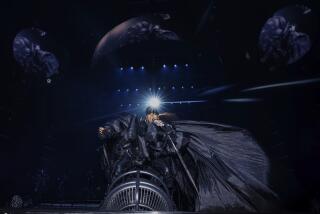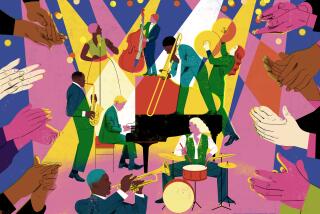ELLINGTONIA GAINING STATURE, STATUE
- Share via
Thirteen years have gone by since Edward Kennedy Ellington died, yet his figure today looms larger than ever on the world music scene. Not only jazz groups but also pop artists are using Ellington medleys as staples of their repertoire.
Ellington left such a vast recorded legacy that new gems are constantly being discovered. This week five compact discs, under the umbrella title “Duke Ellington: The Private Collection,” containing more than five hours of previously unreleased material, were issued by LMR records.
RCA has transferred to CD (6287-RB) one of the greatest Ellington albums of all, “And His Mother Called Him Bill,” a set of compositions by Billy Strayhorn, recorded by Ellington shortly after the death in 1967 of his perennial associate composer.
In fact, along with the Ellington boom, there is a corollary surge of posthumous interest in Strayhorn. In addition to the RCA album, two new sets of Strayhorn’s music have just been released: one by pianist Marian McPartland on Concord CJ 326 (reviewed here last week), and another by fluegelhornist Art Farmer, “Something to Live For” (Contemporary C14029).
Ellington is even on the best-seller charts, probably for the first time ever. “Digital Duke,” recorded by an all-star band with Branford Marsalis, Eddie Daniels, Clark Terry, Louis Bellson and others, directed by Mercer Ellington for GRP Records, has been on the jazz lists for seven weeks and at last report had reached the No. 3 slot.
Most remarkably, Ellington in the near future will be standing tall not only in the charts but quite visibly in New York’s Central Park, where a 20-foot-tall statue of him, crafted by L.A. sculptor Robert Graham (perhaps best known locally for his Olympic Gateway commission in 1984), will be placed at 110th Street and Fifth Avenue. The statue will show Ellington, on a platform atop three columns, in a typical pose, standing at the keyboard, his right hand raised to conduct, his left hand playing.
Ellington will thus become the first jazz artist ever to be commemorated in this manner in the city where he leaped to fame almost 60 years ago. “It’s all part of a logical pattern,” says Mercer Ellington, who now leads the latest incarnation of the Ellington band. “Pop is taking his place alongside Gershwin and the other giants, partly because a whole new generation is becoming conscious of his music. There are millions of young adults, 20 to 30, who were just kids when he died, and their growing awareness is contributing to the new wave of interest.
“I’ve seen the evidence at firsthand. When we begin to play ‘Sophisticated Lady,’ people of all ages recognize it and start applauding. A couple of nights ago, we played at a theater in Milburn, N.J., to a sold-out house and there was a standing ovation for the orchestra.”
The Ellington statue project stems from the vision of Bobby Short, the singer and pianist, thanks to whose dedication the Duke Ellington Memorial Fund came into being.
“I’ve been an Ellington fan almost all my life,” Short said recently in an telephone interview from his summer home in the South of France. “I met him when I was 11, at his manager’s office, when I was the boy-prodigy pianist. He played me the score for his new Cotton Club show, and I was thrilled beyond belief.
“Years later, I moved to California and lived with Harold Brown, the brother of Duke’s trombonist Lawrence Brown, so I became a part of the Ellington family. I knew Strayhorn well, and I was crazy about Ivie Anderson, Duke’s singer, and mingled with the whole band.
“It occurred to me some years ago that right here on the Riviera we have a bust of Sidney Bechet in Juan les Pins, and in Nice, at the Jardins de Cimiez where the jazz festival takes place every year, they unveiled a bust of Louis Armstrong in 1974, with Princess Grace attending the ceremony--she worked with Louis in ‘High Society.’
“It just didn’t seem right that we have nothing like this for Duke in our own country. I went to my attorney and arranged to form a nonprofit memorial fund. A friend in California recommended Robert Graham as the best representational sculptor around and a great fan of Ellington.”
Everyone involved with the Ellington project thinks big; among them is Graham, who informed Short that the statue (to be sculpted in bronze) will cost over $900,000
“We’re already a third of the way there, what with individual contributions and a fund-raiser we held in New York,” Short said. “On my birthday, Sept. 15, I’ll be bringing my trio out West for another big fund-raiser at the Beverly Wilshire.”
This gala cabaret and supper party, chaired by Quincy Jones and Joe Smith, will not exactly aim at hoi polloi; the price will be $250 a head and, given the room’s capacity of 600, Short hopes to be close to the halfway mark by the time he heads back to New York, where he will take part in yet another fund-raiser Oct. 19 at Avery Fisher Hall, with Jessye Norman and the Amherst Saxophone Quartet.
That Ellington’s likeness will be prominently on view as a reminder of his contribution to the arts in this century is welcome news; still, valuable though these tributes are, the most important reminder of all is the music itself. Following are the details about the previously mentioned albums:
“STUDIO SESSIONS: CHICAGO, 1956.” LMR CD 83000 (40 West 57th St., New York 10019). One need only listen to the first couple of cuts to be reminded that Ellington’s was the greatest jazz orchestra ever, particularly during the years 1939-1970. The clarity of sound is amazing on this pre-stereo volume. Of the 15 tunes, only six are familiar (“Jump for Joy,” “Satin Doll”), but even these are heard in versions totally different from those previously released. Of the others, six are variations on the blues form, which Ellington used endlessly. “Do Not Disturb” is an unknown ballad that could have become a standard had Duke introduced it instead of leaving it, along with so many other masterpieces, on the shelf. 5 stars.
“DANCE SESSIONS: CALIFORNIA, 1958.” LMR CD 83001. Taped at a dance date the band played at Travis Air Force Base, this too has its incandescent moments, but time is wasted on arrangements written by outsiders (“Stomping at the Savoy,” “One O’Clock Jump”) and expendable vocals; somebody even sings “Autumn Leaves” in French. Moreover, Johnny Hodges and Cat Anderson had taken the night off. If you can’t afford all five sets, this is the first one to skip. 3 1/2 stars.
“STUDIO SESSIONS: NEW YORK, 1962.” LMR 83002. Again there are two unctuous vocals, but in a sense this is the most fascinating set of all, since all but a couple of the instrumental tracks are unknown. The full band is heard on only eight of the 16 numbers; the brass section is absent on the rest, but Ellington’s incomparable sax team is in full flower, and Paul Gonsalves’ tenor, toward whom these sessions were heavily tilted, is magnificently framed at all tempos, from “Take It Slow” (with the composer, Strayhorn, at the piano) to the thunderbolt-paced “E.S.P.” 4 1/2 stars.
“STUDIO SESSIONS: NEW YORK, 1963.” LMR CD 83003. Only four full band items out of 16, listing heavily toward Ray Nance’s superbly stylized cornet. Again there are new treatments of very early works, plus several unfamiliar pieces, along with the original version of Strayhorn’s “Isfahan” played by Johnny Hodges. No vocals. 4 stars.
“THE SUITES.” LMR CD 83004. “The Degas Suite” consists of a dozen fragments from a score written by Ellington for a 1968 film that was abandoned when funds ran out. Played by 10 members of the orchestra, this shows how skillfully Ellington adapted himself to the medium, inspired by the drawings and paintings of Degas (Ellington gave up a career in painting to become a musician). The rest of this CD comprises fascinating bits and pieces from Duke’s score for a ballet, “The River,” not intended for release in this form although, as annotator Stanley Dance points out, they offer enlightening glimpses of the composer’s sketchbook, blueprints on which the ballet was eventually built. By now (1970), Ellington was experimenting with sounds he had seldom used, such as flute, xylophone and timpani. 5 stars.
More to Read
The biggest entertainment stories
Get our big stories about Hollywood, film, television, music, arts, culture and more right in your inbox as soon as they publish.
You may occasionally receive promotional content from the Los Angeles Times.









